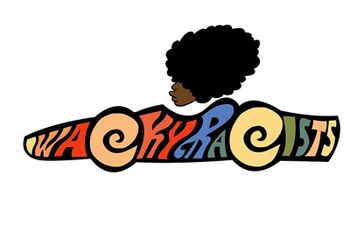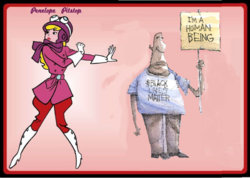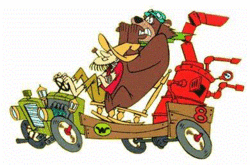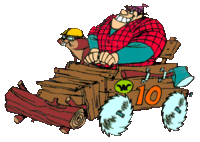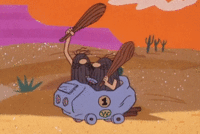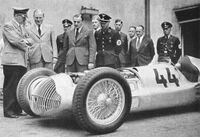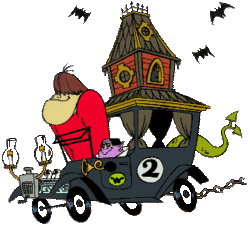Wacky Races
In 1966 things were looking grim for traditional, conservatives in the Bible Belt: hippies were tuning in, turning on and dropping out, while feminists were losing their bras, but not in a sexy way. Augustus “Cog” Zucker, Grand Fleagle of the Alabama Klan, spoke for many when he stood on the steps of the Capitol in Montgomery to deliver his annual state of state of the state address.
| “ | Four score and seven years ago our fathers brought forth on this continent, Jim Crow legislation, conceived in spite, and dedicated to the proposition that all men may be created equal but that don’t mean they’re as good as us.
Now we are about to engage in a new Civil War, testing whether this nation can long endure racial-mixing, miscegenation and the whining of lib-tards. We are met on what will be the great battlefield of that war. We have come to dedicate ourselves to the future of our race, to reinforce the supremacy of our genetic heritage and to ensure that black folks ride at the back of the bus. But, in a larger sense, we cannot dedicate - we cannot consecrate – we cannot hallow – the Caucasian race while Washington Commies compel us to share lunch-counters, drinking fountains and public washrooms with lesser folks. The world will little note, nor long remember what we say here but they can never forget what we do if we find the courage to set burning crosses in the yards of the elderly, and scream abuse at little girls trying to attend the schools of their choice. It is for us, the living, to dedicate ourselves to complete the work of previous generations of chauvinists and xenophobes. We here highly resolve that the brain-dead shall not have died in vain – that this state, under the influence of moonshine, shall have a new birth of prejudice – and that government of black people, by white people, for rich people, shall not perish from the South. |
” |
— Cog Zucker
| ||
Sadly for the Klan, the mood of the nation was shifting. New generations appeared to be losing interest in the traditional Southern sports of tarring, feathering and lynching. The popularity of NASCAR continued to soar, but it was yet to gain its status as the natural home of Good Ole Boys and red necks. Zucker, however, sensed an opportunity. If he could influence the minds of grade-schoolers obsessed with champion drivers David Pearson and Richard Petty, he knew he would have them for life. Soon he approached animators Hanna-Barbera with his ideas – and the Wacky Racists were born.
Southern Stereotypes[edit | edit source]
The characters that featured regularly in the Wacky Racists were carefully designed to attract young white boys from a range of socio-economic backgrounds. According to Zucker, to mould the minds of the next generation, the Wacky Racists needed to have “the appeal of the Hair Bears without the afros, the color of The Banana Splits without the degenerate nods to drug-culture, and the smarts of Yogi Bear without the lack of respect for authority. Most importantly, as they race through our beautiful landscape, our drivers will show humanity’s God-given dominion over nature every bit as much as The Flintstones - but without promoting the anti-Christian, evolutionist, dinosaur conspiracy.” To this end, he felt that at least some of the Wacky Racists should be typical inhabitants of the Deep South that yound viewers could aspire to live down to.
William Hanna was enthusiastic but Joseph Barbera insisted on some changes to Zucker’s designs. One of his tweaks was to the character of Crimson O’Hara who had been envisaged as a nineteenth century cotton heiress. Dressed in crinolines, Zucker imagined her imbued with the natural superiority of southern gentry and the disdain for the suffering of others that is every Georgian’s heritage. His sketch of her vehicle, The Plantation Porsche, had been modelled on the gilded splendour of the Imperial State Carriage, which had made a big impression during the coronation of Queen Elizabeth. To bring the Plantation Porsche into line with the series ethos, the six white horses had been replaced by forty field slaves and the two liveried coachmen by one gnarled overseer with a suitable indifference to the well-being of his charges and a more enthusiastic attitude to use of the whip.
Barbera felt that animating eighty legs would be too complicated and the design slowly morphed into the Compact Pussycat – a lurid pink coupe that, according to Andy Warhol, “resembled a Barbie Race-car designed by a three-year-old on ketamine”. Following the threat of copyright litigation from Gone with the Wind studio, Warner Brothers, Crimson became Penelope Pitstop. Still a southern belle with a distinctive Georgian drawl, she was now more likely to be put her foot down on the gas rather than merely intoning “Hey-lp! Those fellahs are catchin’ us. Don’t make me sell yo’ pickaninnies down the rivah.”
Square of jaw, strong of limb and as chivalrous as an eighteenth-century courtier, Peter Perfect represented as the ideal southern man. Zucker insisted Peter’s car, The Turbo Terrific, should “embody masculinity in every way”. William Hanna duly designed a phallic dragster which could quickly zoom to ninety miles an hour but was unable to sustain its top performance for more than ten minutes at a time before the bonnet popped and hydraulic fluid leaked from under the hood.
Peter was to show no interest in ladies of other cultures as the Wacky Racists toured the world. Instead, his relationship with Penelope was to be respectful, considerate and more than anything, chaste. Zucker and Barbera agreed that Peter should always be shown to be in the lead, though he might lose if forced stop to assist Penelope with mechanical difficulties, or if required to lead a cavalry charge against Yankees, homosexuals, trades-unionists and other social undesirables. When not driving, Peter took a keen interest in the high-tech gadgetry his mechanic, Sam, installed in the Turbo-Terrific but, according to Zucker “takes no mind of Sam beyond what is natural between two bachelors with shared interests.”
The Arkansas Chuggabug was Barbera’s idea. He felt that both Pitstop and Perfect represented only upper-class southerners, while much of the white population held blue-collar jobs and lived simple lives with only a handful of slaves to abuse. In collaboration with Zucker, he created Lazy Luke – a typical hillbilly backwoodsman who steered his car with bare feet, powered his steam-powered vehicle from a rickety boiler and enjoyed light-hearted blood-feuds with his neighbours. Luke’s sister/wife was quickly cut from the original designs and replaced instead with Bubba – a three hundred pound African-American as devoted to Luke as he is dim-witted. When the NAACP threatened to prosecute if this crude racial stereotype was broadcast on national television, Bubba became Blubber – an enormous cowardly brown bear obsessed with fried chicken and watermelon.
Oklahoma’s Army Surplus Special survived the editing process broadly unchanged. Intended to promote the honour of military service at a time when dodging the Vietnam draft was becoming rife, this vehicle was a hybrid armoured-car/tank which, to the glee of the industrial-military complex, was powered entirely by firing shells in the reverse direction.
Zucker felt that the commander of this vehicle should embody everything admirable in the American serviceman. Consequently, the initial model for the tank commander was General Douglas MacArthur and the vehicle was to be powered by the severed limbs of Bonus Army demonstrators and self-immolating North Korean prisoners. To his fury, the US army refused permission for its insignia to be used unless the MacArthur character was toned down. Eventually, a compromise was reached; new commander, Sergeant Blast, was allowed to bully and berate his driver, Private Meekly, as befitted the relationship between US non-commissioned officers and their charges. However, he was not permitted to question the sexual proclivities of Meekly’s mother, or utter any lines that ended with “… queers and steers.”
The West and Pacific Northwest[edit | edit source]
It was clear even to Zucker that The Wacky Racists would make little impression beyond the South unless its cast of characters was more representative of (white) society nationally. Together with Barbera he began to create new characters that would appeal to grade-schoolers in less-enlightened parts of the United States.
The Pacific Northwest was represented by the Buzz Wagon. This unique vehicle was entirely made of wood, with four circular saw-blades as wheels. These could for cut with ease through a range of obstacles from trees and log-cabins, to protesting students and hippy sit-ins. Initially christened Ruthless Ruffcutt, the driver’s state of origin was never specified though Zucker said that "Rufus was probably from Washington but I never really trusted folks that named their state after a Virginian."
At Hanna’s insistence and much to Zucker’s disgust, while he retained his lightning ability to construct wooden bridges and other structures, Rufus' penchant for slaughtering native American Tlingit, Nootka and Chinook people to make better use of their ancestral hunting grounds was canned. This "emasculation" was compounded when Ruffcutt’s wife, Ruth, (who had been intended to be a submissive, non-driving, cooking-obsessed mother-figure) was edited into a very different kind of beaver, Sawtooth. Rufus had only a moderately successful racing career but went on to found an international chain of coffee shops, the proceeds of which he used to fund the creation of a Professor's chair for the University of Seattle Bigfoot Research Center.
Western states worried Zucker. There had been plenty of time, he felt, for westerners to eliminate the remnants of the Apache and Comanche people. The failure to do so was a clear sign of effeminacy in Western men, their insistence on wearing high heel boots and leather trousers being tantamount to a threat to decent Christian life. Western boys needed a better example. But what could it be?
Cowboys were everywhere but Zucker's misgivings about "what they get up to out their on the range far from their womenfolk" would not allow him to countenance a cowboy race-driver. Something new was required. A visit to Colorado provided the inspiration for the Bouldermobile and its drivers, The Slag Brothers. These two hirsute cavemen, Rock and Gravel, represented primitive white people – strong and ingenious enough to create a competitive race-car without the advantages metal tools or control of fire, let alone the internal combustion engine. Acceleration was achieved by hitting the Bouldermobile with large clubs, a process intended to inspire young boys to admire physical strength and to develop their arm-muscles for a future in which being able to rep[eatedly hit people over the heads with clubs might allow them to join the Mississippi State Police and "Give that two bit Bolshevik, Martin Luther King, and his cronies a taste of southern justice". At Zucker’s insistence, the Slag Brothers' vocabulary was limited to statements along the lines of “Raga-radda, flat tyre” so that young boys would would know exactly how eloquent than a typical Mississippian Police officer needed to be.
The Mid-West[edit | edit source]
All three men thought it important to have some representation of the Midwest. But with no discernible cultural or geographic features between the Appalachian and Rocky Mountains, what could they choose? Predictably, it was Zucker himself who solved the problem. From Ohio to Nebraska, millions of Midwesterners traced their descent from nineteenth century German immigrants. He came up with two characters that the he felt represented overlap between American, German and Klan culture.
The Crimson Haybaler combined the aeronautic ability of First World War ace, Baron Manfred von Richthofen, and the crop-sprayers familiar to little boys across the flyover states. The Red Max’s German accent survived pre-production, as did his ability to slice-up opponent’s cars with his propeller. Sadly, Zucker was forced to scale back his enthusiasm for strafing rivals. With regret he agreed to shelve plans for the Red Baron to drop Chlorine on his opponents so that they slowly drowned as their lungs filled with their own body-fluids, admitting that this might be “perhaps a little much for the under-5s”. Nevertheless, the Red Baron retained his penchant for invading Belgium, bayonetting babies and 2letting nuns find out what they've been missing all this time".
The Convert-a Car was an ingenious vehicle that, at the flick of a switch, could transform into a boat, a hot-air balloon, train, hovercraft or V2 victory weapon. Joseph Hanna refused to animate the army of Jewish slave workers toiling underground at Peenemunde to create the vehicle, and toned down the gleeful destruction of Rotterdam and London that its driver, Professor Werner von Braun, oversaw. Renamed Pat Pending, he became a happy-go-lucky, if absent-minded, inventor who combined attempting to win the weekly Wacky Race with overseeing the Apollo Moon program and supervising the liquidation the Untermensch of Jersey City.
When not driving or tinkering with the Convert-a-car, Pat Pending was often seen hanging out at the country retreat of his nation's dynamic, young leader, inventing ever more powerful weapons and plotting the downfall of the Soviet Union. When Hitler died in season two, however, the Professor was forced to spend his free time at Camp David inventing ever more powerful weapons and plotting the downfall of the Soviet Union.
Arguably the capital of the Midwest, Chicago is a culturally-diverse melting-pot that is home to people of a thousand different creeds and cultures, and every colour. Inevitably, Zucker reserved a special place for its denizens within his private Hell. He chose to represent the Windy City as fedora-wearing, prohibition era, pint-sized gangsters, with unmeasurably low IQ and a hopelessly uncompetitive 1928 Cadillac that could only accelerate when all seven dwarfs picked up the chassis and ran. This, he felt, would drive home an appropriate message to his young audience: Crime is wrong, Corruption is wrong, Italians are worse.
Other Characters[edit | edit source]
Rejected characters from Zucker’s initial list included his New England representative, The Yellow Yankee. Modelled on a 1943 M4 Sherman tank, both Hanna and Barbera felt that the Yellow Yankee’s vehicle, The Carpet-Bagger Coupe, was too similar to the Army Surplus Special. Zucker’s insistence that its inability to fire munitions other than flowers and hash, as well its absence of any gears other than reverse, made it different and distinct enough but could not persuade the producers that "two tanks are always better than one". It is one of the tragedies of animation-history that the Yellow Yankee was consigned to the cutting-room floor before the world could enjoy his holier than thou moral certainty and patrician arrogance.
A similar fate awaited his West Coast driver, Way-Out Willie. The Bolshevik Bug – Willie’s psychedelically decorated VW Beetle – was intended not to finish any race, it’s driver being unable to steer except into trees, pedestrians or fire-hydrants due to his constant popping of pills, snacking on shrooms and sucking on acid-laden sugar cubes. Hanna was keen on both Willie and the Bug, but felt that animating Willie's three naked “wife-lettes” might do more harm than good in promoting the intended anti-hippy message to teenage boys across the nation.
The Gruesome Twosome represented the Old World. The drivers of the Creepy Coupe hailed from Transylvania and Zucker intended them to be typical Europeans – technologically backward, hairy, surrounded by bats and obsessed with the ghosts of the past. Though they could rely on Dragon-power for short bursts of acceleration they would be unable to regularly win races due to the poor quality of their automotive engineering and a lack of a winning mentality "typical of anyone forced to grow up reliant on socialised medical care".
As with all Europeans, the Gruesome Twosome live in (and drive) a stately home, and deny Christ at all opportunities. Zucker insisted that it should be clear that they, like other Europeans, would spend eternity in Hell - a place he was sure was somewhere between Poland and Hungary.
The only other European-inspired team was, perhaps, the eventual fan-favourite. Dick Dastardly. Zucker had long felt that Britain’s decision to grant independence to its African, Caribbean and Asian empire was a betrayal of the white race. How much better for the world, he speculated, would it have been for the UK to hand over its inferior peoples (Maoris, Aborigines, Zulus, Malays and Celts etc) to the tender ministrations of the Third Reich, under the guidance of such exemplars of the master-race as Joseph Goebbels, Hermann Goeringand the mono-bollocked Fuhrer himself.
In vengeance, Zucker modelled his moustache-twirling antihero on British actor, Terry Thomas who specialised in portraying the kind of Upper Class twit that he blamed for allowing the Japanese to seize Singapore and for not crucifying Gandhi when they had the chance. Muttley, Dick Dastardly’s smaller green companion, was Zucker’s take on the Irish who he consider “The natural servants of the English. Subhuman. More so even than dogs. Green ones.” A little known wacky racists fact is that Muttley's wheezy snicker represented the Gaelic language and his most common pronouncement, “Snazza frazza rashin' fashin' Rick Rastardly”, is the first line of the Irish National Anthem, Amhrán na bhFiann.
Zucker was disappointed that Dastardly quickly became a much-loved antihero to millions of children across the globe. Despite being vociferous on the subject in private, Zucker refused to publicly denounce his wife's design of Dastardly’s purple rocket, The Mean Machine. The Mean Machine's flanks throbbed as it struggled to contain the power that made it capable of great speed, but it was rarely able to get to the climax of the race without breaking down. "Girls know implicitly what young boys need to learn about Dick..." Mrs Zucker wrote in the New York Times "Only losers come first."
